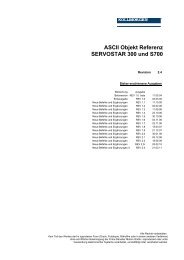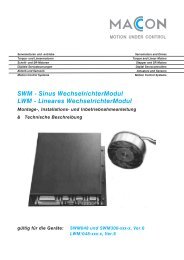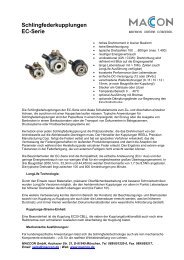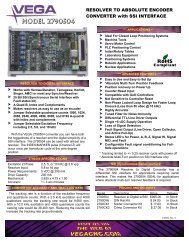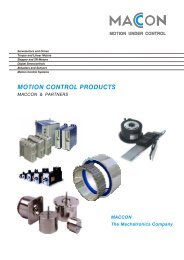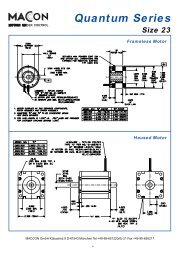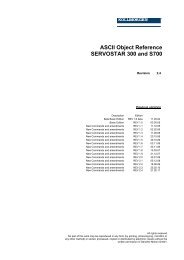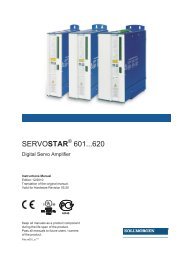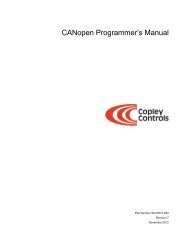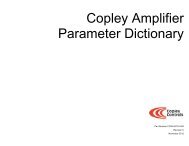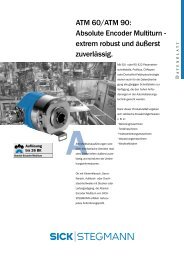Datasheet Stepnet Panel - Maccon.de
Datasheet Stepnet Panel - Maccon.de
Datasheet Stepnet Panel - Maccon.de
You also want an ePaper? Increase the reach of your titles
YUMPU automatically turns print PDFs into web optimized ePapers that Google loves.
FEATURES<br />
<strong>Stepnet</strong><br />
<strong>Stepnet</strong><br />
+<br />
-<br />
<strong>Stepnet</strong> <strong>Panel</strong><br />
Stepper Enco<strong>de</strong>r<br />
+ -<br />
Stall?<br />
Stepper Enco<strong>de</strong>r<br />
STP<br />
<strong>Stepnet</strong> is a DSP based drive for two-phase step motors that operates as a no<strong>de</strong> on a CAN bus or as a stand-alone drive that takes step<br />
motor pulses to command motor position. It operates from line-isolated DC power supplies.<br />
As a CAN no<strong>de</strong> it operates un<strong>de</strong>r the CANopen protocol DSP-402 for motion control <strong>de</strong>vices. The functions supported inclu<strong>de</strong> Profile<br />
Position, Profile Velocity, Interpolated Position, and Homing Mo<strong>de</strong>s. In Profile Position Mo<strong>de</strong> a single PDO (Process Data Object) can<br />
command a position profile with programmable acceleration, <strong>de</strong>celeration, maximum speed, and target position. The acceleration can<br />
be trapezoidal or S-curve. Interpolated Position Mo<strong>de</strong> works with multiple PDO’s each of which specifies position, velocity, and time.<br />
For this reason this mo<strong>de</strong> is sometimes called PVT (Position, Velocity, Time) mo<strong>de</strong>. The drive uses a cubic-interpolation algorithm to<br />
connect the PVT points such that the motor satisfies the PVT parameters at each point while moving along a path that connects the<br />
points smoothly. In PVT mo<strong>de</strong> long moves of complex shapes can be performed. Profile Velocity mo<strong>de</strong> has controlled acceleration,<br />
<strong>de</strong>celeration, and maximum velocity for speed control application with no <strong>de</strong>fined positions. Profile Torque mo<strong>de</strong> is available when the<br />
stepper is operated in Servo Mo<strong>de</strong>.<br />
Multiple axes can be synchronized so that moves are coordinated. This emulates the functions normally performed by motion-controller<br />
cards or chips which can now be eliminated in many cases reducing cost and system complexity.<br />
<strong>Stepnet</strong> also operates as a stand-alone drive taking pulses from controllers that output pulses in the Step/Direction or Count-Up/Count-<br />
Down mo<strong>de</strong>. Electronic gearing is supported when the position commands come from a quadrature enco<strong>de</strong>r. The ratio of enco<strong>de</strong>r counts<br />
at the inputs to microsteps at the motor is programmable.<br />
MICROSTEPPING<br />
Step motors can be viewed as brushless motors with a large number of poles, or electrical<br />
cycles per revolution. The two windings are spaced at 90 electrical <strong>de</strong>grees. Reversing the<br />
currents in each winding produces a 180 <strong>de</strong>gree phase shift. The result is full-stepping. This<br />
kind of operation can be noisy and the large angular change per step excites the rotor to<br />
produce un<strong>de</strong>sirable vibrations. In microstepping, the phase currents are sinusoidal and the<br />
change in electrical angle per step can be programmed such that the motor moves with less<br />
noise and vibration.<br />
Copley Controls, 20 Dan Road, Canton, MA 02021, USA Tel: 781-828-8090 Fax: 781-828-6547<br />
Web: www.copleycontrols.com Page 4 of 16<br />
RoHS<br />
STALL DETECTION<br />
Adding an enco<strong>de</strong>r to the motor gives position feedback to the drive.<br />
When the measured movement of the motor differs from the comman<strong>de</strong>d<br />
position by an amount that is programmable a motor stall is<br />
indicated. The drive can then signal the control system that a motor<br />
stall has occurred, or can send a message over the CAN bus with the<br />
same effect. In this mo<strong>de</strong> the stepper is operated in open-loop mo<strong>de</strong><br />
where the drive changes the phase currents based on the comman<strong>de</strong>d<br />
position of the motor.<br />
SERVO MODE<br />
The stepper motor is now operated as a brushless servo<br />
motor. Motor phase currents are adjusted dynamically<br />
in response to the difference between comman<strong>de</strong>d position<br />
and motor position as fed back by the enco<strong>de</strong>r.<br />
Field-oriented control (vector control) of the motor<br />
currents gives a wi<strong>de</strong>r range of motor speeds without<br />
the possibility of stalling. If the load exceeds motor’s<br />
capability excess following error can be <strong>de</strong>tected and<br />
drive programmed to take appropriate action.




